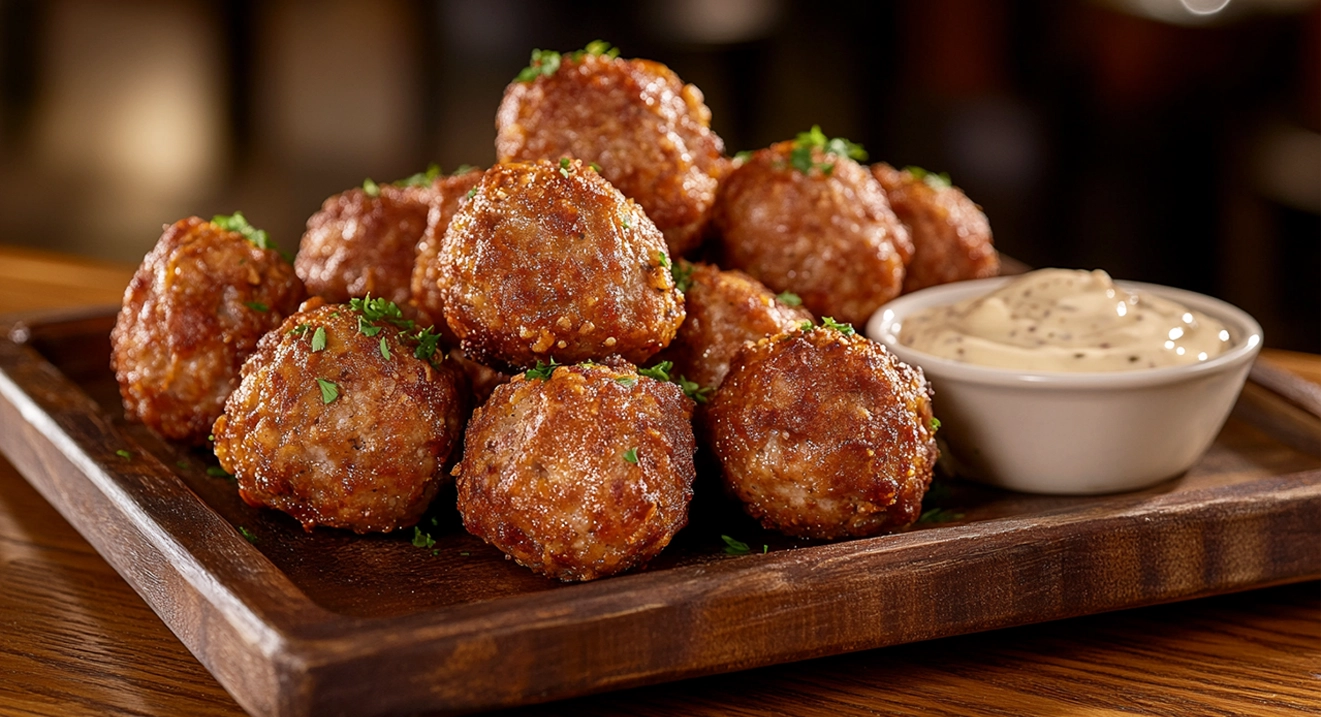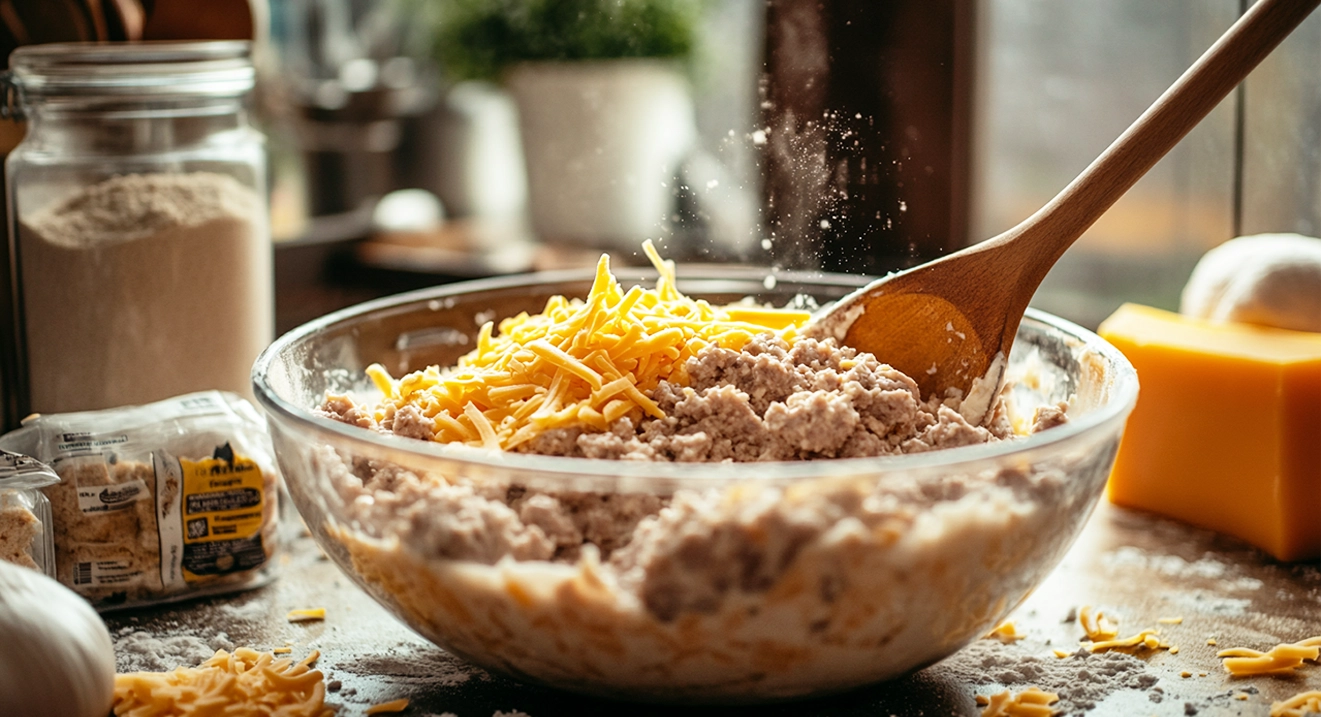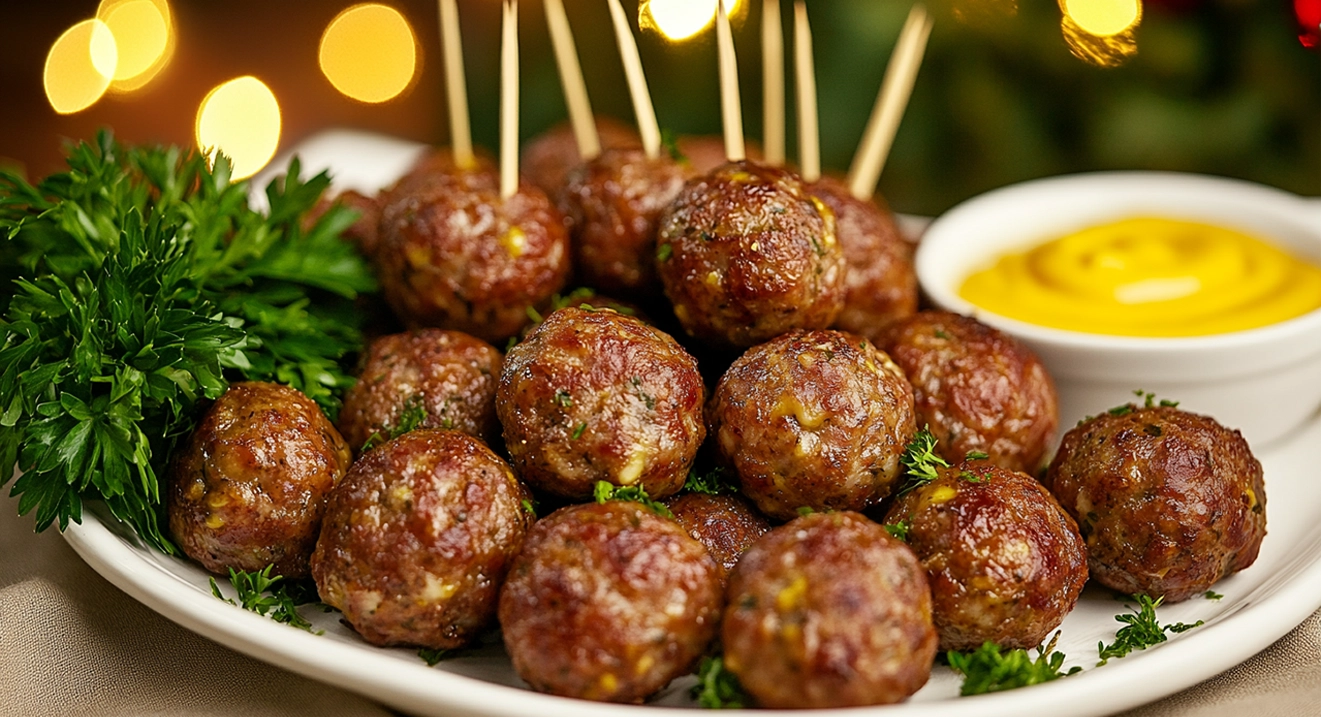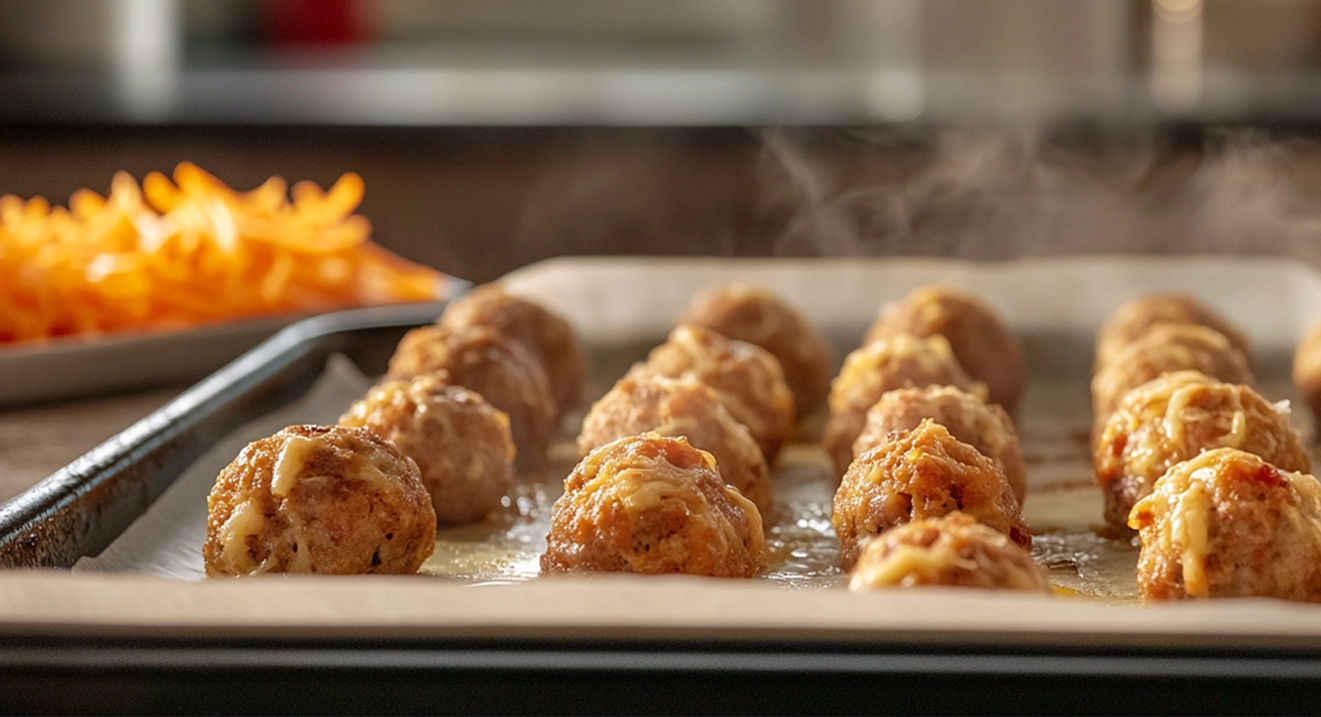
Table of Contents
Introduction to Sausage Balls Recipe
What Are Sausage Balls?
Sausage balls are a delightful combination of savory ingredients that blend to create bite-sized, flavorful treats. Traditionally made with ground sausage, shredded cheese, and a binding agent like biscuit mix, these morsels are perfect for snacking, appetizers, or breakfast. Known for their simplicity and adaptability, sausage balls can be customized with various spices, cheeses, or even different types of sausage to suit individual tastes.
Whether served warm at a gathering or enjoyed as a quick snack, sausage balls are cherished for their hearty texture and rich, cheesy flavor. They are a staple at potlucks, holiday parties, and casual get-togethers.
History and Origin of Sausage Balls
The origins of sausage balls are unclear but deeply rooted in Southern American cuisine. These delectable bites became popular in the mid-20th century thanks to the widespread availability of pre-mixed biscuit or pancake mix, which simplified the preparation process. Bisquick, a brand synonymous with easy baking, played a significant role in popularizing sausage balls as a go-to recipe for busy households.
Sausage balls also align with the Southern tradition of hearty, comforting foods emphasizing flavor and practicality. Over time, they have evolved into a versatile dish, finding their way onto menus and family tables across the United States and beyond. Today, sausage balls are a testament to Southern culinary ingenuity and a symbol of shared meals and communal enjoyment.
Why Sausage Balls Recipe Are the Perfect Appetizer
Popular Occasions for Sausage Balls
Sausage balls are a versatile appetizer that shines at various events and gatherings. Their easy preparation and universal appeal make them a go-to choice for:
- Holiday Parties: Sausage balls are a staple on holiday appetizer spreads, from Thanksgiving to Christmas, adding a warm and comforting touch.
- Game Day Gatherings: These savory bites pair excellently with dips and other finger foods, perfect for tailgating or watching the big game.
- Potlucks and Picnics: Easy to transport and serve, sausage balls are crowd-pleasers that rarely leave leftovers.
- Family Reunions: Their nostalgic flavor and simple ingredients make them a favorite for sharing at family gatherings.
- Breakfast or Brunch Buffets: Their protein-packed recipe pairs well with other breakfast items, offering a hearty start to the day.
Unique Appeal of Sausage Balls Recipe for All Ages
One of the reasons sausage balls stand out as a beloved appetizer is their broad appeal.
- For Kids: Their small, bite-sized shape makes them easy for little hands to grab, and the mild flavors are kid-friendly without being bland.
- For Adults, the savory combination of sausage and cheese significantly satisfies more mature palates when enhanced with additional spices or gourmet ingredients.
- Customizable Flavors: Sausage balls can be tailored to suit dietary preferences or specific flavor profiles, making them a hit across various demographics.
- Easy to Eat: No forks, knives, or plates are necessary—sausage balls are a convenient, mess-free option for mingling and snacking.
Essential Ingredients for Sausage Balls Recipe
Choosing the Right Sausage
The sausage is the star ingredient of sausage balls, and selecting the right type is key to achieving the perfect flavor and texture.
- Classic Pork Sausage: Traditional recipes often use ground pork sausage for its rich flavor and juicy texture.
- Spicy Variations: For those who enjoy a little heat, spicy sausage options like hot Italian sausage or chorizo add an exciting kick.
- Turkey or Chicken Sausage: For a lighter alternative, ground turkey or chicken sausage can be substituted without sacrificing flavor.
- Vegetarian Options: Plant-based sausage crumbles can create a vegetarian version of this classic dish.
When choosing sausage, opt for fresh, uncooked varieties, as precooked sausage may affect the texture of the sausage balls.
Types of Cheese to Use
Cheese adds flavor and binding properties to sausage balls, making them an essential ingredient.
- Sharp Cheddar Cheese: The most commonly used cheese, sharp cheddar, provides a bold and tangy flavor that complements the savory sausage.
- Colby Jack or Monterey Jack: These milder cheeses work well for a creamier and less intense flavor.
- Parmesan Cheese: Adding a small amount of Parmesan can enhance the flavor complexity of the sausage balls.
- Custom Blends: Feel free to experiment with blends like cheddar and pepper jack for a spicy twist or cheddar and mozzarella for a stretchy, gooey texture.
For the best results, grate the cheese yourself from a block, as pre-shredded cheese often contains anti-caking agents that can affect the texture.
Perfect Flour Choices: Regular vs. Bisquick
The choice of flour or a baking mix like Bisquick plays a significant role in the consistency and ease of preparation.
- Bisquick or Baking Mix: A pre-made mix like Bisquick is the traditional choice and simplifies the process. It contains flour, leavening agents, and shortening, creating a light and fluffy texture.
- All-Purpose Flour: For a DIY approach, you can combine regular flour with baking powder and a pinch of salt to replicate the leavening effects of Bisquick.
- Gluten-Free Alternatives: For those with dietary restrictions, gluten-free baking mixes work wonderfully and yield similar results.
Kitchen Tools You’ll Need
Essential Tools for Preparation
Having the right tools makes preparing sausage balls easier and more efficient. Here are the must-haves:
- Mixing Bowl: A large mixing bowl is essential for combining sausage, cheese, and flour or biscuit mix without making a mess.
- Wooden Spoon or Spatula: For mixing ingredients thoroughly. Some prefer using their hands to ensure even distribution.
- Baking Sheet: A flat, nonstick baking sheet lined with parchment paper is perfect for evenly baking sausage balls.
- Measuring Cups and Spoons: Accurate ingredients like flour or baking mix measurements are crucial for consistent results.
- Oven: A standard oven preheated to the correct temperature ensures that your sausage balls cook evenly and maintain their texture.
Optional Tools to Elevate Your Recipe
To take your sausage ball preparation to the next level, consider using these optional tools:
- Stand Mixer: For effortless mixing, especially when preparing larger batches, a stand mixer with a paddle attachment can save time and effort.
- Cookie Scoop: A small cookie scoop ensures uniform sausage ball sizes, leading to even cooking and a professional appearance.
- Silicone Baking Mat: A reusable silicone mat provides a nonstick surface and ensures easy cleanup.
- Cooling Rack: Placing baked sausage balls on a cooling rack prevents them from becoming soggy underneath as they cool.
- Thermometer: An instant-read thermometer helps ensure your sausage balls are cooked to a safe internal temperature of 160°F (71°C).
- Food Processor: A food processor can be a handy addition for grating cheese quickly or evenly mixing the dough.
Step-by-Step Instructions for Sausage Balls Recipe

Follow these simple steps to prepare delicious sausage balls:
Ingredients
- 1 pound (450g) ground sausage (turkey, or your preferred type)
- 2 cups shredded sharp cheddar cheese (or cheese of your choice)
- 1 ½ cups Bisquick or baking mix (or a homemade equivalent)
- Optional: 1 teaspoon garlic powder, ½ teaspoon paprika, or other spices for added flavor
Instructions
1: Preheat the Oven
- Preheat your oven to 375°F (190°C).
- Line a baking sheet with parchment paper or a silicone baking mat to prevent sticking.
2: Prepare the Dough
- Combine the ground sausage, shredded cheese, and baking mix in a large mixing bowl.
- Add any optional spices to enhance the flavor. Garlic powder, onion powder, or paprika are popular choices.
- Mix the ingredients thoroughly using a wooden spoon, spatula, or your hands. Ensure the cheese and baking mix are evenly distributed throughout the sausage.
3: Shape the Sausage Balls
- Scoop out small portions of the mixture, about 1 to 1 ½ inches in diameter.
- Roll them between your palms to form evenly sized-balls.
- Place the sausage balls on the prepared baking sheet, spacing them about 1 inch apart.
4: Bake the Sausage Balls
- Bake in the oven for 18-22 minutes or until the sausage balls are golden brown and fully cooked.
- A food thermometer ensures the internal temperature reaches 160°F (71°C) for safe consumption.
5: Serve and Enjoy
- Remove the sausage balls from the oven and let them cool on the baking sheet for 5 minutes.
- Transfer them to a serving platter or cooling rack if not serving immediately.
- Serve warm or with your favorite dipping sauces, such as ranch, honey mustard, or marinara.
Tips for Success
- Cheese Grating: Use freshly grated cheese for the best texture, as pre-shredded cheese may not melt as smoothly.
- Adjusting Moisture: If the mixture feels too dry, add a tablespoon of milk to help bind the ingredients.
- Make-Ahead Option: Prepare the sausage balls in advance and refrigerate them uncooked for up to 24 hours. Bake them fresh when needed.
Variations and Customizations

Gluten-Free Sausage Balls Recipe
For those with gluten sensitivities or dietary preferences, sausage balls can easily be made gluten-free without compromising flavor.
Ingredients:
- Substitute a gluten-free baking mix for Bisquick. Popular brands include Bob’s Red Mill or King Arthur Gluten-Free Baking Mix.
- Ensure the sausage and cheese are certified gluten-free (check labels for hidden gluten in seasonings or additives).
Instructions:
- Follow the standard recipe, substituting the gluten-free baking mix for Bisquick.
- To achieve the right dough consistency, you may need to adjust the moisture by adding a small amount of milk or water.
Spicy Sausage Balls: Adding Heat
For a fiery twist, spice up your sausage balls with these options:
Spicy Ingredients:
- Hot Sausage: Replace regular sausage with hot Italian sausage, spicy chorizo, or sausage seasoned with cayenne or red pepper flakes.
- Pepper Jack Cheese: Swap cheddar cheese for pepper jack to add a creamy yet spicy flavor.
- Extra Heat: Mix in ½ teaspoon of cayenne pepper, 1 teaspoon of smoked paprika, or a dash of your favorite hot sauce to the dough.
Optional Dipping Sauce:
Serve with a spicy ranch or sriracha mayo to complement the heat.
Vegetarian Sausage Balls Options
Vegetarian sausage balls are just as delicious and satisfying as a meat-free alternative.
Ingredients:
- Plant-Based Sausage: Use a vegetarian or vegan sausage substitute, such as Beyond Sausage or MorningStar Farms crumbles.
- Vegan Cheese: Opt for dairy-free shredded cheese if making vegan sausage balls.
- Egg Substitute: If the plant-based sausage lacks binding properties, add one tablespoon of flaxseed meal mixed with three tablespoons of water as a binder.
Instructions:
- Mix the plant-based sausage, vegan cheese, and a gluten-free or regular baking mix just as you would in the classic recipe.
- Adjust moisture levels if needed, as plant-based ingredients sometimes require a bit of extra liquid.
Serving Ideas:
Pair vegetarian sausage balls with marinara sauce or a tangy vegan aioli for dipping.
Nutrition and Serving Size
Nutritional Breakdown of Sausage Balls
The nutritional content of sausage balls varies depending on the ingredients used and the size of the servings. Below is a general estimate based on a traditional pork sausage, cheddar cheese, and Bisquick recipe.
Per Sausage Ball (1-inch in diameter):
- Calories: 80-100
- Protein: 4-5g
- Fat: 6-7g
- Saturated Fat: 2-3g
- Carbohydrates: 3-4g
- Sugars: Less than 1g
- Fiber: 0g
- Cholesterol: 15-20mg
- Sodium: 120-150mg
Note:
- Using leaner sausage or low-fat cheese can reduce the calorie and fat content.
- Gluten-free or alternative baking mixes may alter the carbohydrate count.
Recommended Serving Size
Sausage balls are rich and satisfying, so a modest serving size is often enough.
- Appetizer: Serve 3-5 sausage balls per person as a starter or party snack.
- Main Dish or Breakfast: If serving as part of a meal, consider 6-8 sausage balls per person, paired with side dishes like scrambled eggs, a fresh salad, or fruit.
Tips for Managing Portions
- For calorie-conscious guests, prepare more petite sausage balls (¾-inch diameter) to keep portions lighter.
- To balance the meal, include healthier sides, such as vegetable platters or whole-grain crackers.
Frequently Asked Questions About Sausage Balls
Why Are My Sausage Balls So Dry?
Dry sausage balls are often a result of insufficient moisture or improper proportions. To avoid this issue:
- Balance Ingredients: Ensure the sausage, cheese, and baking mix ratio is correct. Too much baking mix can dry them out.
- Add Liquid: If the mixture feels crumbly, add 1-2 tablespoons of milk or water to help bind the ingredients.
- Choose Juicier Sausage: Use a sausage with a higher fat content, as lean sausage may result in drier balls.
- Avoid Overbaking: Watch the oven to prevent overcooking, which can dry out the sausage balls.
What Are Sausage Balls Made Of?
Sausage balls are a simple and delicious combination of ingredients, typically including:
- Ground sausage (pork, turkey, or plant-based alternatives)
- Shredded cheese (sharp cheddar is most common)
- A binding agent like Bisquick or a homemade baking mix
- Optional additions include spices (e.g., garlic powder, paprika) and a splash of milk for moisture.
What Can I Use Instead of Bisquick in Sausage Balls?
If you don’t have Bisquick on hand, you can make a simple substitute:
- DIY Baking Mix: Combine 1 cup of all-purpose flour, 1 ½ teaspoons of baking powder, ¼ teaspoon of salt, and 1 tablespoon of butter or shortening.
- Gluten-Free Option: Use a gluten-free baking mix, which works just as well for those with dietary restrictions.
- Alternative Flours: Whole wheat flour or almond flour can be used, but you may need to adjust for moisture and binding properties.
How Long Will Sausage Balls Keep?
Sausage balls can be stored and enjoyed later if adequately handled:
- Refrigerated: Cooked sausage balls can be stored in an airtight container in the refrigerator for up to 4 days. Reheat them in the oven or microwave before serving.
- Frozen: For extended storage, freeze uncooked sausage balls on a baking sheet, then transfer them to a freezer bag. They can be frozen for up to 3 months. Bake directly from frozen, adding a few extra minutes to the cooking time.
- At Room Temperature: For safety, do not leave sausage balls out at room temperature for more than 2 hours.

Final Thoughts
Why Sausage Balls Will Always Be a Hit
Sausage balls have earned their place as a timeless favorite for good reason. Their irresistible combination of savory sausage, gooey cheese, and tender texture appeals to all ages and tastes. Easy to prepare and customize, they are versatile enough to suit any occasion—a holiday party, a quick breakfast, or a snack for game day.
Their simplicity, paired with the option to experiment with flavors, makes them a dish that both seasoned cooks and beginners can enjoy making. Sausage balls will bring smiles and satisfied appetites no matter how you serve them.
Encouragement to Try and Experiment
Don’t be afraid to make this classic recipe your own! Sausage balls are a blank canvas for creativity:
- Try new spices or herbs to enhance the flavor.
- Experiment with different types of sausage, cheeses, or baking mixes to suit your preferences.
- Make them gluten-free, vegetarian, or spicy to accommodate dietary needs and taste buds.
